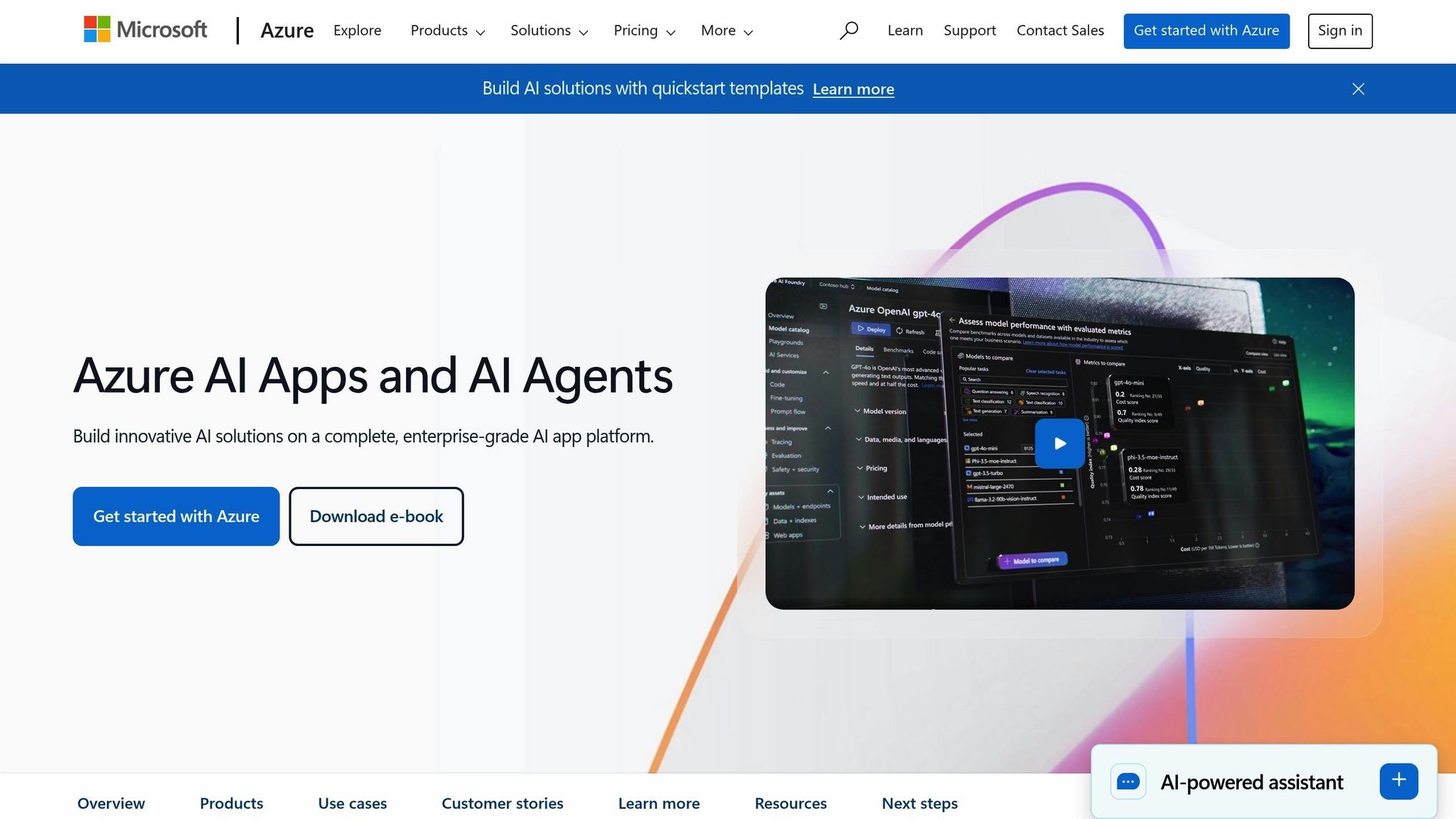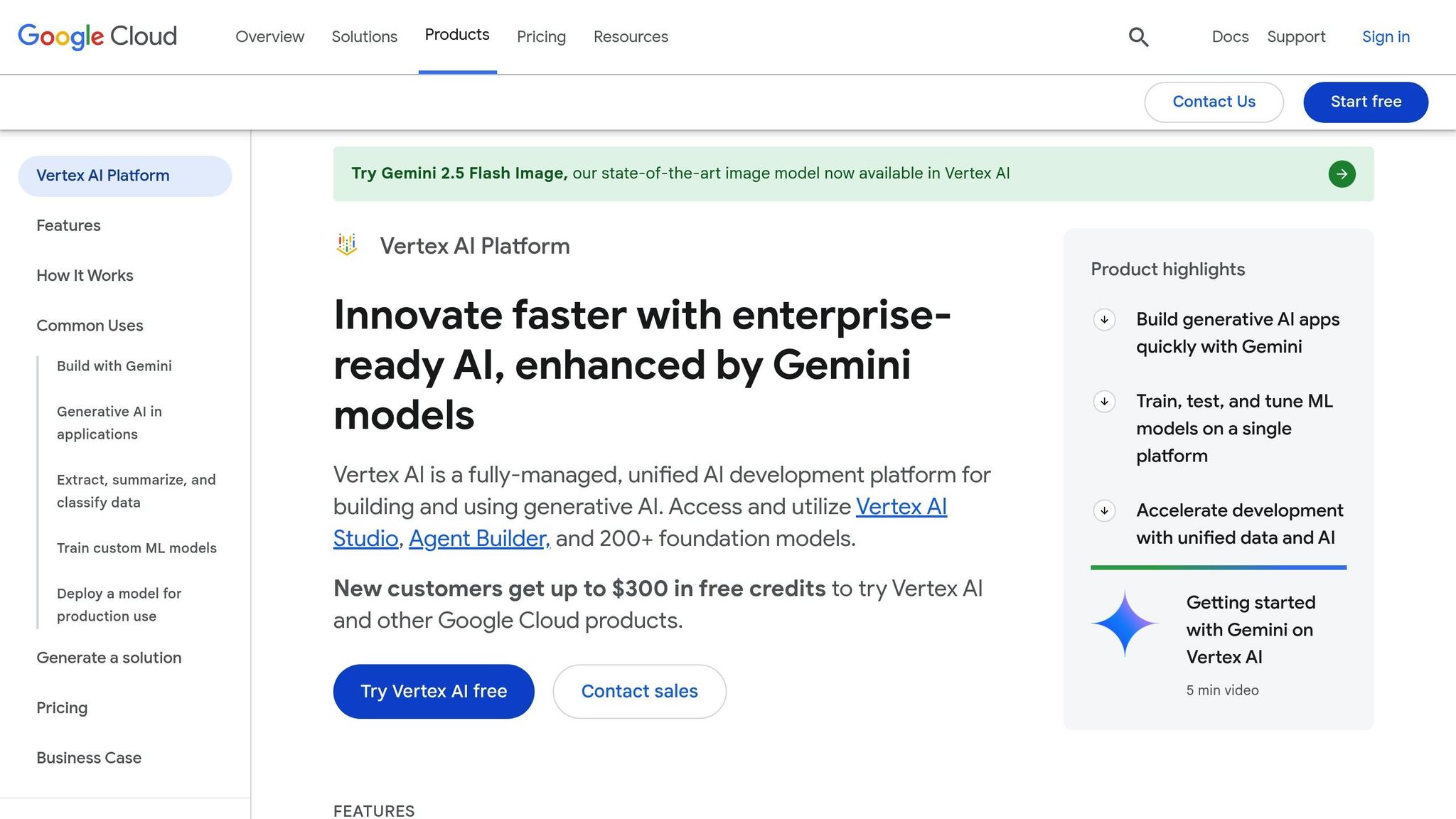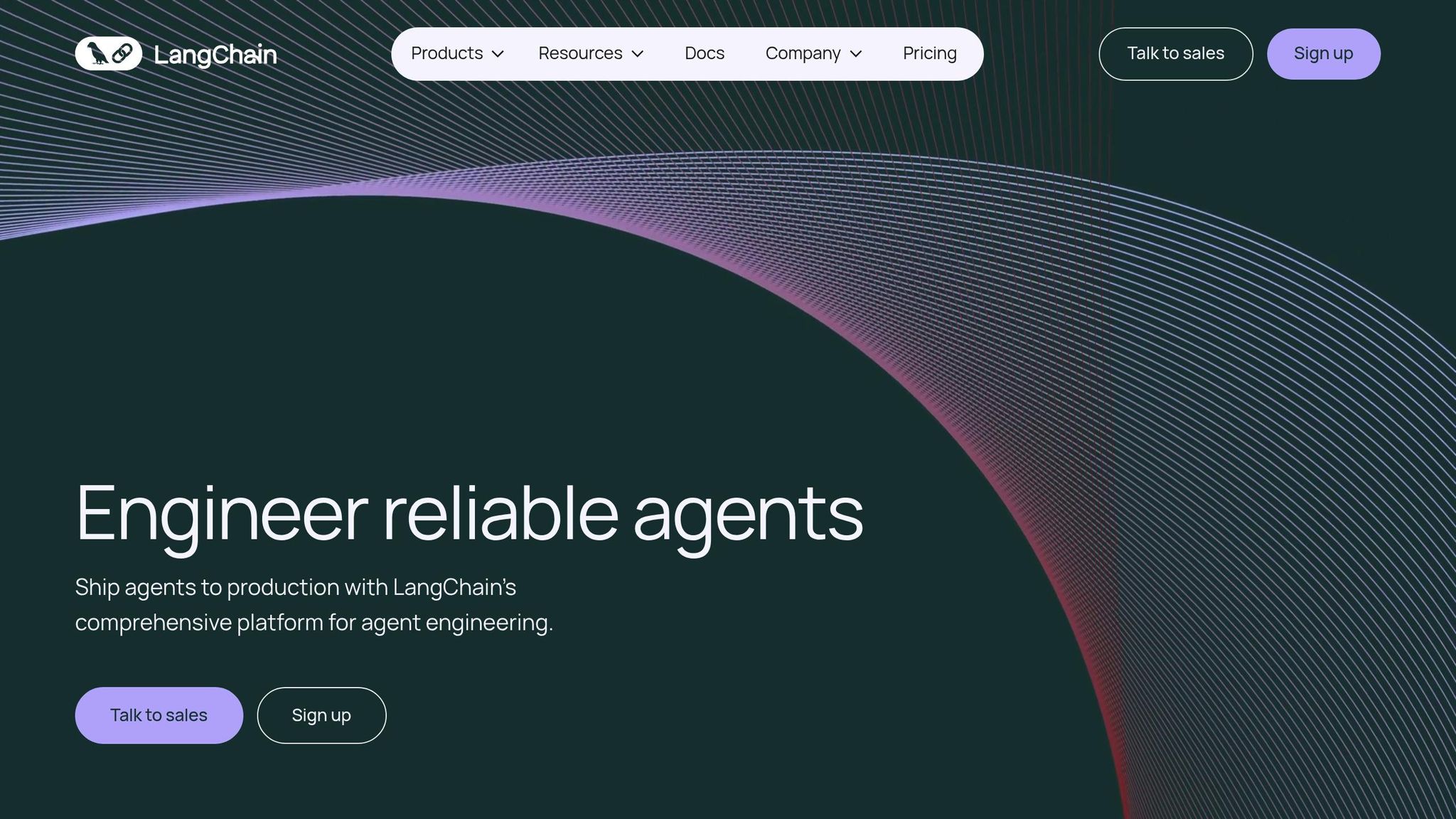
Managing AI workflows can be challenging, especially with the increasing adoption of large language models (LLMs). The right analytics tools simplify this process, offering real-time tracking, cost visibility, and integration with various models. Here's a quick overview of the top tools:
| Tool | Model Support | Real-Time Monitoring | Cost Management | Integration Focus |
|---|---|---|---|---|
| Prompts.ai | 35+ LLMs | Advanced | Full visibility | Multi-provider, BI systems |
| Microsoft Azure AI | Azure OpenAI models | Comprehensive | Standard billing | Microsoft ecosystem |
| Google Vertex AI | Google models | Detailed | Cloud-based | Google Cloud services |
| LangChain | Multi-provider | Customizable | Manual setup | Developer-centric workflows |
Each tool has unique strengths. Prompts.ai is ideal for cost-conscious teams needing multi-model support, while LangChain suits developers looking for flexibility. For those tied to specific ecosystems, Microsoft Azure AI and Google Vertex AI offer smoother integration but may limit model variety. Choose based on your needs, whether it's cost control, ecosystem alignment, or advanced customization.

Prompts.ai brings together access to over 35 leading language models - including GPT-4, Claude, LLaMA, and Gemini - through a single, secure interface. Instead of juggling multiple vendors and scattered tools, teams gain streamlined access to all major LLM providers while ensuring top-notch security and governance.
The platform’s multi-provider setup allows seamless switching between different LLMs without the hassle of rewriting code or managing separate API integrations. Teams can compare outputs from various models side-by-side within the same workflow, making it easier to determine which model fits specific needs. Prompts.ai also connects with tools like Slack, Gmail, and Trello, embedding AI capabilities directly into existing workflows. With its API-first design, analytics data integrates effortlessly into current business intelligence systems and monitoring dashboards, offering a unified view of AI performance across the tech stack. Native integrations further streamline API management.
Prompts.ai provides real-time performance tracking for AI workflows, capturing key metrics like response times, error rates, and output quality. Teams can monitor token usage, API latency, and model-switching decisions as they happen, making it easier to spot and resolve bottlenecks or performance dips. The platform also tracks how effective prompts are across different model versions and configurations, sending alerts when performance issues arise. All of this monitoring feeds into broader workflow insights, which are covered in more detail later.
Building on its interoperability, Prompts.ai ensures smooth transitions between analytics and model management. The platform offers version control for prompts, letting teams test new configurations without disrupting live workflows. It also supports A/B testing of prompt versions to directly measure their impact on business outcomes. Advanced features like LoRA (Low-Rank Adaptation) training and AI agent creation allow teams to fine-tune models for specific tasks while keeping governance centralized.
Prompts.ai rounds out its feature set with tools that provide clear visibility into AI spending. Its FinOps capabilities track token usage, API costs, and resource consumption in real time, breaking down expenses by model provider, team member, and workflow. Teams have reported saving between 15% and 25% on LLM API costs thanks to improved efficiency and detailed tracking. The TOKN credit system simplifies cost management by pooling credits across teams and projects while offering detailed analytics. Enterprise pricing starts at $99 per member per month for the Core plan, which includes 250,000 TOKN credits, unlimited workspaces, and full analytics, ensuring costs align with actual usage and eliminating unnecessary expenses tied to fixed subscriptions.

Microsoft Azure AI is a cloud platform designed to support the creation, deployment, and management of AI workflows tailored for businesses. As part of the broader Microsoft ecosystem, it works seamlessly with Microsoft Power Automate, enabling smoother workflow automation across various processes.
The platform prioritizes enterprise-level security and scalability, making it easier for organizations to integrate AI solutions across their operations without disruptions.
Up next, we’ll explore how Google Vertex AI takes these capabilities further in the realm of AI workflow analytics.

Google Vertex AI is a machine learning platform created by Google to simplify the process of building, deploying, and scaling AI workflows. It offers tools for automated model training, hyperparameter tuning, and scalable deployment, making it easier to manage complex AI projects from start to finish.
With its extensive features, Vertex AI serves as a strong choice for businesses looking to manage their AI workflows efficiently and effectively.

LangChain provides developers with a streamlined way to design and oversee AI workflows. This lightweight framework is tailored for creating applications that leverage large language models, offering built-in tools for real-time analytics and monitoring. It features modular components that make it easy to track performance, monitor token usage, and connect with external analytics systems. This allows developers to fine-tune workflows to meet specific needs. Additionally, LangChain's design supports integration with multiple LLM providers, enabling advanced monitoring, cost analysis, and resource management. Its detailed logging and customizable analytics dashboards help ensure workflows remain efficient and effective.
When it comes to managing AI workflows, each tool brings its own strengths and challenges. Understanding these differences is essential for organizations to choose a platform that aligns with their goals and technical setup. Below is a breakdown of the key benefits and limitations of each tool.
Prompts.ai stands out for its transparent cost tracking and seamless integration across multiple models. Its FinOps layer monitors every token used across 35+ language models, including GPT-5, Claude, and Gemini. With the pay-as-you-go TOKN credit system, organizations can reduce AI expenses by up to 98%. The unified interface also simplifies operations by minimizing tool sprawl. However, for companies heavily invested in existing cloud ecosystems, additional integration efforts may be needed to fully implement the platform.
Microsoft Azure AI offers smooth integration within the Microsoft ecosystem, making it a strong choice for organizations already using Azure services. It provides robust enterprise security, unified billing, and advanced monitoring dashboards, along with automated scaling features. The primary downside is the risk of vendor lock-in and potentially higher costs for businesses not already tied to Microsoft's infrastructure.
Google Vertex AI delivers exceptional machine learning capabilities, especially for data-heavy tasks. It integrates well with Google Cloud services and offers advanced AutoML features. Real-time monitoring provides detailed insights into performance metrics and resource usage. However, its complexity can be overwhelming for smaller teams, and costs can rise quickly without careful oversight.
LangChain is a flexible option designed for developers who want precise control over AI workflows. Its modular architecture supports multiple LLM providers and allows for detailed logging and custom analytics dashboards. The trade-off is the need for significant development expertise and ongoing maintenance, which may not suit teams looking for a managed solution.
| Tool | Interoperability | Real-time Monitoring | LLM Integration | Cost Transparency |
|---|---|---|---|---|
| Prompts.ai | Excellent (35+ models) | Advanced FinOps tracking | Native multi-provider | Full token-level visibility |
| Microsoft Azure AI | Good (Azure ecosystem) | Comprehensive dashboards | Limited to Azure OpenAI | Standard cloud billing |
| Google Vertex AI | Good (Google Cloud) | Detailed performance metrics | Google models + partners | Cloud-based cost tracking |
| LangChain | Excellent (multi-provider) | Customizable logging | Extensive provider support | Manual implementation required |
The right choice depends on your organization's priorities - whether that's cost management, flexibility, or ecosystem alignment. Prompts.ai is ideal for cost-conscious enterprises seeking transparency, while LangChain is better suited for development teams needing maximum customization. For businesses already committed to specific cloud ecosystems, sticking with Microsoft Azure AI or Google Vertex AI often ensures smoother integration, though it may come with limitations in model variety or cost efficiency.
Selecting the right analytics tool depends on your specific priorities and existing infrastructure.
Here’s a quick recap of each tool's standout features:
Ultimately, your decision should align with your top priority - whether it's controlling costs, ensuring compatibility with existing systems, or enabling tailored development. Many organizations find success by focusing on their immediate needs and selecting the tool that best addresses them. By matching your choice to your operational goals, you can enhance the efficiency and effectiveness of your AI workflows.
Prompts.ai comes equipped with a FinOps layer designed to provide real-time insights into your AI workflows. This feature keeps a close eye on usage, spending, and return on investment (ROI), ensuring you have a clear picture of your costs at all times.
By analyzing and fine-tuning resource allocation, it pinpoints inefficiencies and trims unnecessary expenses, helping you get the most out of your AI investments.
LangChain provides developers with a practical framework to streamline AI workflows, making it easier to incorporate large language models (LLMs) into a variety of applications. With tools designed for smooth data analysis, performance tracking, and automation, it simplifies the creation of efficient, scalable AI-powered solutions.
A standout feature of LangChain is its emphasis on interoperability, enabling developers to integrate multiple tools and data sources effortlessly. This adaptability tackles common hurdles in AI workflows, such as managing intricate pipelines and maintaining reliable model performance. For developers aiming to simplify their AI projects while ensuring accuracy and flexibility, LangChain is a reliable option.
When evaluating Microsoft Azure AI and Google Vertex AI, it's important for businesses to consider how each platform aligns with their integration needs, current infrastructure, and long-term objectives.
Microsoft Azure AI stands out for its seamless compatibility with other Microsoft services like Azure DevOps and Power BI. This makes it a strong contender for organizations already entrenched in the Microsoft ecosystem. In contrast, Google Vertex AI is particularly effective when paired with Google Cloud services, offering advanced machine learning capabilities that are well-suited for data-heavy projects.
Factors to weigh include how well each platform integrates with existing tools, the simplicity of deployment, scalability, and overall cost. Additionally, businesses should evaluate the support provided by each platform for large language models and AI workflow automation, ensuring these features meet their operational demands and future growth strategies.


